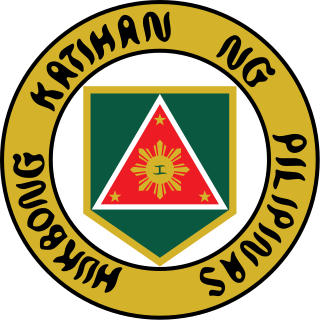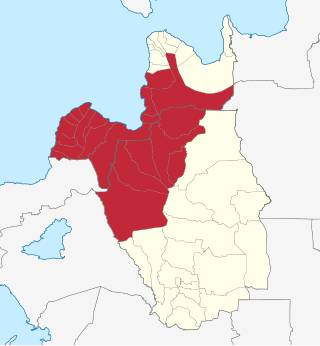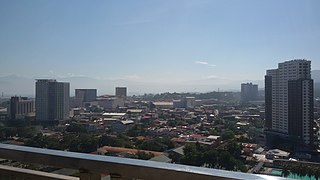The Xavier University – Ateneo de Cagayan, also known simply as the Ateneo de Cagayan or Xavier is a private, Catholic, coeducational, basic and higher education institution. It is operated by the Philippine Province of the Society of Jesus in Cagayan de Oro, Misamis Oriental, Philippines. Founded in 1933 as the Ateneo de Cagayan, it became the first higher education institution in Mindanao to receive a university status a year before its sister school Ateneo de Manila. It was given its present name in honor of the Jesuit missionary St. Francis Xavier.

The Philippine Constabulary was a gendarmerie-type military police force of the Philippines from 1901 to 1991, and the predecessor to the Philippine National Police. It was created by the American occupational government to replace the Spanish colonial Guardia Civil, happened on the 19th century history of the Philippines. It was the first of the four branches of the Armed Forces of the Philippines. On January 29, 1991, it was merged with the Integrated National Police to form the Philippine National Police.

Northern Mindanao is an administrative region in the Philippines, designated as Region X. It comprises five provinces: Bukidnon, Camiguin, Misamis Occidental, Misamis Oriental, and Lanao del Norte, and two cities classified as highly urbanized, all occupying the north-central part of Mindanao island, and the island-province of Camiguin. The regional center is Cagayan de Oro. Lanao del Norte was transferred to Northern Mindanao from Region XII by virtue of Executive Order No. 36 in September 2001.

Misamis Oriental, officially the Province of Misamis Oriental, is a province located in the region of Northern Mindanao in the Philippines. Its capital, largest city and provincial center is the city of Cagayan de Oro, which is governed independently from the province.

Emmanuel Neri Pelaez was a Filipino public servant and politician who served as the 6th Vice President of the Philippines from 1961 to 1965.

Edilberto Evangelista was a Filipino civil engineer and a revolutionary.
Lumbia Airfield, formerly known as Lumbia Airport and Cagayan de Oro Airport, is an air base and was the main airport that served the general areas of Cagayan de Oro and Northern Mindanao, in the province of Misamis Oriental in the Philippines. It was the second busiest airport in Mindanao, after Francisco Bangoy International Airport in Davao City before the opening of Laguindingan Airport.

The Philippine Army (PA) is the main, oldest and largest branch of the Armed Forces of the Philippines (AFP), responsible for ground warfare and as of 2021 had an estimated strength of 101,000 soldiers backed by 100,000 ready reserves. The service branch was established on December 21, 1935, as the Philippine Commonwealth Army. The Philippine Army has engaged in many conflicts including the ongoing Communist rebellion in the Philippines, the Moro conflict and, alongside other national military forces, in conflicts of international scope.
The legislative districts of Misamis Oriental are the representations of the province of Misamis Oriental in the various national legislatures of the Philippines. The province is currently represented in the lower house of the Congress of the Philippines through its first and second congressional districts.
Antonio Gabriel "Tony" Maestrado La Viña is a Filipino lawyer, educator, and environmental policy expert. A former undersecretary of the Department of Environment and Natural Resources (DENR), executive director of the Manila Observatory, and dean of the Ateneo School of Government, he currently teaches law, governance, and philosophy in the Ateneo de Manila University, University of the Philippines, University of Santo Tomas, De La Salle University, Xavier University, San Beda University, Polytechnic University of the Philippines, Lyceum of the Philippines University, Pamantasang ng Lungsod ng Maynila, Far Eastern University, Ateneo de Zamboanga, Liceo de Cagayan, and the Philippine Judicial Academy. In addition to these teaching responsibilities, La Viña is the director of the Energy Collaboratory of the Manila Observatory. He was also the chair of the Partnership Council, Partnership for the Environmental Management of the Seas of East Asia. Likewise, he was chair of the Board of Trustees of the Forest Foundation of the Philippines until September 2020.

The Roman Catholic Archdiocese of Cagayan de Oro is an archdiocese of the Catholic Church in the Philippines.

Oscar "Oca" Seriña Moreno is a Filipino politician who served as the mayor of Cagayan de Oro, Philippines, the provincial capital of Misamis Oriental, from 2013 to 2022. He is a lawyer by profession and a former banker before he entered public service.

Metropolitan Cagayan de Oro, also known as Metro Cagayan de Oro, is the fourth largest metropolitan area in the Philippines. It is located on the northern coast of Mindanao, and comprises the two chartered cities of Cagayan de Oro and El Salvador and the fourteen municipalities of Misamis Oriental which are Alubijid, Balingasag, Claveria, Gitagum, Initao, Jasaan, Laguindingan, Libertad, Lugait, Manticao, Naawan, Opol, Tagoloan, and Villanueva and the six municipalities of Bukidnon which are Manolo Fortich, Baungon, Libona, Malitbog, Sumilao and Talakag. According to the 2015 Philippine census, Metro Cagayan de Oro has a population of 1,687,159 people.

Cagayan de Oro (CDO), officially the City of Cagayan de Oro, is a 1st class highly urbanized city in the region of Northern Mindanao, Philippines. It is the capital of the province of Misamis Oriental where it is geographically situated but governed administratively independent from the provincial government. According to the 2020 census, it has a population of 728,402 people. Cagayan de Oro also serves as the regional center and business hub of Northern Mindanao, and part of the growing Metropolitan Cagayan de Oro area, which includes the city of El Salvador, the towns of Opol, Alubijid, Laguindingan, Gitagum, Lugait, Naawan, Initao, Libertad and Manticao at the western side, and the towns of Tagoloan, Villanueva, Jasaan, Claveria and Balingasag at the eastern side.

The 1990 Mindanao revolt was an uprising that occurred in parts of the island of Mindanao in the southern Philippines. It began when Alexander Noble, a dissident Philippine Army colonel linked to the 1989 Philippine coup attempt against President Corazon Aquino, and his supporters seized two military garrisons in Cagayan de Oro and Butuan without firing a shot and unilaterally proclaimed the independence of the Federal Republic of Mindanao on October 4, 1990, to be led by a civilian-military junta and with an ultimate goal of removing Aquino from office. However, he failed to gain support, and surrendered two days later following attacks by government forces. The revolt was the last overt attempt to overthrow Aquino's government until the end of her term in 1992.

The Vega Ancestral House is one of the 1st Transition Bahay na Bato inspired houses that has remained standing and has witnessed the different colonial periods of the Philippines through its estimated 200 years of existence. Sculpted wooden Atlases are perhaps the most interesting feature of this house that is located in Poblacion, Balingasag, Misamis Oriental. Sculpted wooden atlases, known as "Oti-ot" in the Visayan language, provide support to the second floor protrusion of the house. This house is one important structure in the locality that tourists usually come to visit. Notable personalities like Emilio Aguinaldo and Sergio Osmeña had visited this house.

The Philippine Army was established on December 21, 1935, as the Army of the Philippines, with a general headquarters in Manila, and units and formations based throughout the provinces of the Philippines.

The Northern Mindanao Medical Center (NMMC) is a government hospital in Cagayan de Oro, Philippines. It is managed under the Department of Health.
Camp Edilberto Evangelista is a military installation of the Philippine Army in Cagayan de Oro, Philippines.













